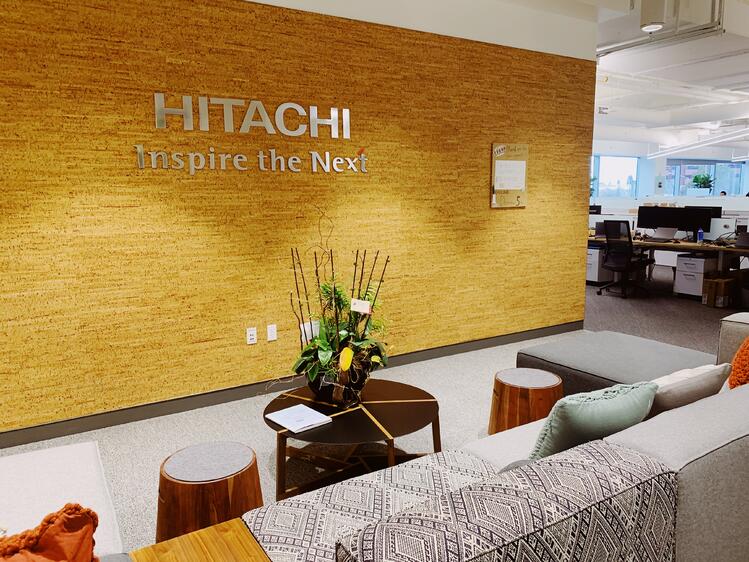Hitachi - Talent Management and Retention Customer Story
Positioning For A Global Future
In 2011, Hiroaki Nakanishi, former CEO and President of Hitachi, had a bold vision for the future: “By fiscal year 2015, we will develop and implement a comprehensive, uniform human resource platform to oversee the Hitachi Group’s 300,000-plus employees that will streamline hiring, personnel administration, compensation, and training on a global basis.”
The challenge for Hitachi was the need to act and grow globally; an aging and shrinking Japanese population dictated that the company globalize to survive. Nakanishi’s unique approach was to think about the necessary transformation from an HR perspective, recognizing that streamlining talent management would be critical for the success of a global organization.
The biggest roadblock to achieving Nakanishi’s ambitious goal was figuring out how to answer questions about top talent, hiring and retention, training, and management; there were no company-wide answers to those questions. To achieve transformation of the company, it was necessary to first transform HR.
Nakanishi stepped down from the CEO position in 2016 and now serves as board chairman for Hitachi, Ltd. He was succeeded by current CEO Toshiaki Higashihara, who has fully embraced Nakanishi’s vision for transformation of the organization via the HR function and kept the initiative moving forward.
Transforming HR To Create Competitive Advantage
Hitachi began redesigning its HR function by establishing a baseline. A survey of HR revealed that over 50% of HR employees’ time was spent on general affairs, recruiting and staffing, and employee/labor relations. Less than 10% of HR employees’ time was devoted to talent management, organizational development, and HR strategy and planning. Another survey of 4,000 managers indicated a disconnect between expectations and delivered results. When asked what they wanted HR to do, managers rated organizational effectiveness, talent development and management, and business growth high—and their satisfaction with how HR was handling those functions much lower. In addition to providing a baseline for the existing HR function, these surveys supported mapping a path to the transformation.
To achieve Nakanishi’s vision, Hitachi needed to create a worldwide human resources database to enable fact-based, data-driven decisions. As a first step toward launching global performance and talent management systems, HR started in 2012 with a homegrown database, HCDB (human capital database), to bring together data about employees of all the various business units.
“When we started implementing new things and had no way to measure how it helped the business, that’s when employee surveys came into play,” said Sunisa Manopchantaroj, Director of Human Resources at Hitachi, Ltd. The following year, the company partnered with Perceptyx to launch the Hitachi Insights employee survey, administered to 173,000 employees of 702 Hitachi subsidiary companies and business units.
A Complex Implementation
As expected, implementing a global survey in over 900 geographically-dispersed companies and business units with more than 300,000 employees was complicated. Perceptyx made recommendations and narrowed the plan down to what Hitachi needed to measure, and assisted HR in presenting the proposal and securing executive buy-in.
Hitachi formed a steering committee to manage roll-out of the survey. The heads of each subsidiary company and business unit were interviewed to find out what they wanted to measure in their unit; the steering committee then reviewed those questions and secured approval for including them in the survey.
These unit-specific questions were critical for obtaining buy-in from unit executives. After the first year of the survey, business units that participated in the following years were sent the questions they included from the previous year and asked if they wanted to change anything; changes were reviewed and cleared by the steering committee. The Perceptyx tool made this type of customization by unit easy to accomplish—employees of the various business units received only the core questions and the questions pertinent to their unit when taking the survey.

Rolling out a survey program in a company as large and complex as Hitachi is not a one-shot proposition. Though individual business units have always had the choice to opt out of the survey, participation company-wide had increased to 87% of 204,016 invitees by 2019.
According to Manopchantaroj, Hitachi ultimately wants to get to a place where it is easier for managers throughout all business units to take action based on survey results. Due to the complexity of the organization, they have not been able to put survey results into many managers’ hands—yet. Currently results are shared with business units’ HR teams so they can see their company’s results, share them, and make action plans. Before results can be shared with managers, the individual business unit has to agree to grant access to managers and allow HR to establish internal benchmarks. By the third or fourth year of survey participation, unit managers start getting access and HR follows up with them for orientation.
At the corporate level, company-wide survey results and analysis are shared on the company intranet for all employees to see. Perceptyx also compiles an executive presentation covering engagement drivers, areas for improvement, and areas with potential for greatest impact.
Hitachi Insights Survey Proved A Valuable Tool
Manopchantaroj said, “We knew we needed to measure what employees are thinking about company strategies, leaders, new technology being implemented, communication, and all the dimensions of engagement. At that time Japan was surveying but it was in Japanese—not very global. We looked at flexibility and tools, and decided to go to Perceptyx for our first global survey. We took the information from Japan to Perceptyx and had them adjust it for a global audience. We launched the global survey for the first time six years ago, and it was very well received. Our companies were excited because of the ease of use of the platform and the ability to use both internal and external benchmarks. That was the starting point where companies outside of Japan got involved; Perceptyx brought it all together.”
For the first time, Hitachi had information about the perceptions of employees across the organization. Since launching the survey in 2013, the company has been able to build a large database of information about employee perceptions and the employee experience. As the results of each annual survey are added to the database, analyzed, and compared to previous survey data, trends and correlations have begun to emerge.
The survey has reinforced what Hitachi knew was an area of opportunity—making sure they have the right people in the right places—and validated the need for the company’s Hi-Next initiative, a comprehensive HRIS database for use in recruiting, performance management, and talent management. Another area of opportunity highlighted by the survey is diversification of the workforce.
“For us, the survey has become a true north,” said Levent Arabaci, GM, Hitachi Human Capital Group. “Prior to working with Perceptyx, our survey of Hitachi, Ltd.'s 100,000 employees in Japan took six months to analyze and a year to get results reported. Perceptyx turned that around with a cutting edge, real-time product. The survey is now one of the most valued tools inside Hitachi.”
Even though the full predictive power of the survey data has not yet been realized, Arabaci said the survey has still been invaluable to the company.
“We look to the survey to see if we are really making improvements in those areas we've prioritized,” he said.
“We share the results with executive committee members and selectively think about what we want to focus on. We talk about it, but also highlight new areas that are emerging. Perceptyx does a great job of drilling down into the issues and cross-referencing to reveal those emerging trends.”

Future Goals For The Hitachi Insights Survey
Ultimately, Hitachi’s goal for its survey program is predictive capability. The company is in the process of implementing a number of HR initiatives, and survey results will be useful in both informing the shape of those initiatives and for correlation to other data.
In 2012, as they were building their HCDB database, Hitachi debuted Global Leadership Development (GLD) to identify and develop the top 500 talents in the company. The following year, the first year of the Hitachi Insights survey, they introduced the Hitachi Global Grade (HGG) for job mapping to identify where managers of the various units are in terms of talent development, so the company has a foundation to use for moving managers to new positions or units. They also implemented Global Performance Management (GPM) to track employee performance and alignment with the global organization. From 2015–2018, they built a learning management system, Hitachi University, open to all employees.
Collectively, these initiatives comprise Hitachi’s Hi-Next database. The goal was to create a system that handles onboarding, individual goal-setting, global performance management, global talent reviews, succession planning, and global learning and development—all in the same online environment. Hi-Next makes talent throughout the business units visible to the parent company and enables Hitachi to make data-driven decisions on promotions.

Currently, the company is uploading data from the Hitachi Insights survey into Hi-Next, so it can be cross-referenced with the data collected through GLD, HGG, GPM, and Hitachi University, to reveal correlations that would otherwise be difficult or impossible to see. Ultimately, this ability to cross-reference will allow Hitachi HR to make predictions about their workforce..
Manopchantaroj said, “We’re trying to look into business strategies and define what we are looking for in employee behavior, and determine if we’re seeing it in the organization. We’re looking at correlations to see what drives engagement and how it can be improved, and how we can use the patterns shown in the data. We’ve just started to analyze the intent to stay question with a view towards attrition prediction.”
All these initiatives are building toward the desired end state for Hitachi’s HR transformation, which will include:
- Recognition that subsidiaries as well as the corporation are best places to work
- Common, shared technology and big data analytics to drive fact-based decisions throughout the company and business units
- Performance and goal alignment as a common practice across Hitachi Group
- Attracting the best talent throughout the world—the right people for the right jobs
- Workforce planning as an integral part of the overall analytics culture created across businesses
- Profitable growth mindset as an integral part of Hitachi culture
- HR functions “built to last”—able to sustain accomplishments, improve and adjust to new business demands, and remain relevant to Hitachi’s future strategy and vision
It’s a big undertaking, but as Arabaci said, “Now that HR has stepped out of the comfort zone, other functions must follow.” At Hitachi, HR is leading the way in a company-wide transformation to position the organization for future success.
Perceptyx is playing a key role in helping the company achieve Hiroaki Nakanishi's vision for a comprehensive people analytics practice to manage talent and drive data-based decision-making throughout the organization.
Want to learn more?

About Hitachi
In the 109 years since its founding, Hitachi Ltd. has grown from a mining machinery repair shop into a $90 billion global company with over 900 subsidiary business units and more than 300,000 employees.
Though Hitachi is still involved in operational technology (OT) as a manufacturer of a wide range of industrial and consumer products, the company has been expanding into information technology (IT) for the past six decades.
The mix of OT and IT business has uniquely positioned Hitachi to leverage digital technologies in the company’s transformation into a social innovation business, with a focus on using its range of capabilities to solve customer problems.
Headquarters: Tokyo, Japan
Industry: Operational & Informational Technology
Number of Employees: 300,000